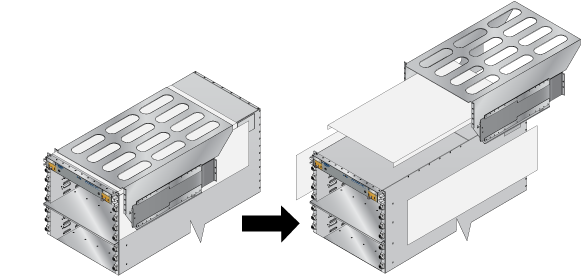Preparation
Site Selection
- Floor Space: Install the switch in an area that provides adequate clearance for removing front and rear components.
The Figure 1 display the dimensions and footprint of the switch clearance requirements.

The Figure 1 display the dimensions and footprint of the switch clearance requirements.
| Switch | Clearance Requirements Dimensions | ||
|---|---|---|---|
| A | B | C | |
| DCS-7804 | 38.4 cm (15.1 in.) | 102.1 cm (40.2 in.) | 58.9 cm (23.2 in.) |
| DCS-7808 | 38.4 cm (15.1 in.) | 102.1 cm (40.2 in.) | 58.9 cm (23.2 in.) |
| DCS-7812 | 38.4 cm (15.1 in.) | 102.1 cm (40.2 in.) | 58.9 cm (23.2 in.) |
| DCS-7816 | 38.4 cm (15.1 in.) | 102.1 cm (40.2 in.) | 58.9 cm (23.2 in.) |
| DCS-7816L | 38.4 cm (15.1 in.) | 102.1 cm (40.2 in.) | 58.9 cm (23.2 in.) |
- Temperature and Ventilation: For proper ventilation, install the switch with ample airflow to the front and back of the switch. The temperature should not go below 0° or exceed 40°C.
Important:
To prevent the switch from overheating, do not operate it in an area where the ambient temperature exceeds 40°C (104°F).
Pour empêcher l'interrupteur de surchauffe, ne pas utiliser il dans une zone où la température ambiante est supérieure à 40°C (104°F).
- Airflow Orientation: The fans direct air from the front panel to the rear panel. Orient the front panel toward the cool aisle.
- Rack Space Requirements: The Table 2 table shows the rack space requirements for each modular switch.
Table 2. Rack Space Requirements Switch Rack or Cabinet (standard 19" EIA) 2-Post 4-Post Switch Height (RU) DCS-7804 No Yes 10 DCS-7808 No Yes 16 DCS-7812 No Yes 23 DCS-7816 No Yes 32 Note: The accessory kit provides the required mounting hardware for each switch. - Power Requirements: Arista switches require a minimum number of operating AC or DC power supplies in all chassis and for each power domain of switches with multiple power domains. Refer to Cabling the Power Supplies for more details regarding your switch.
Important:
DC cables should be protected with circuit over-current protection devices and circuit disconnect means. To turn off a unit, power must be disconnected from ALL power cables.
DC câbles doivent être protégés avec dispositifs de protection de surintensité circuit et moyens de déconnexion du circuit. Pour éteindre une unité, l'alimentation doit être débranchée de TOUS les câbles d'alimentation.
- Other Requirements: Select a site where liquids or objects cannot fall onto the equipment and foreign objects are not drawn into the ventilation holes. Ensure these guidelines are met:
- Clearance areas to the front and rear panels allow for unrestricted cabling.
- All front and rear panel indicators can be easily read.
- AC power cords can reach the input connectors from the AC power outlet.
- DC power cables can reach the input connectors from the DC power distribution unit.
Tools and Parts Required for Installation
- A mechanical device capable of lifting the chassis being installed (Table 1.)
- Torque reading nut driver (for DC power supplies.)
- #2 Phillips head screwdriver.
Rack Mount
The Table 3 table shows the rack components required for each modular switch.
| Switch | Rack or Cabinet (standard 19" EIA) | ||
|---|---|---|---|
| Rack Screws (1) | Rack Nuts (2) | Notes | |
| DCS-7804 | 21(3) | 21(3) | 4-post installation |
| DCS-7808 | 21(3) | 21(3) | 4-post installation |
| DCS-7812 | 27(3) | 27(3) | 4-post installation |
| DCS-7816 | 35(3) | 35(3) | 4-post installation |
| DCS-7816L | 35(3) | 35 | 4-post installation |
1 The accessory kit includes screws that fit many common equipment racks.
2 Rack nuts are only for racks with unthreaded, rack-post holes.
3 These are in addition to the rack-mount kit screws required for the cradle.
Unpacking and Moving the Switch
The DCS-7816 accessory kit includes bolts and lifting brackets (Figure 2) that must be attached to the top of the chassis with the bolts supplied for lifting the chassis from the pallet onto the transport lift. You can use any appropriate lifting mechanism/tool to unload the switch. A platform lift is recommended for the transportation and installation of the switch. The rack mounting cradle is shipped nested upside down over the top of the chassis for all switches (Figure 3). A protective film on the top and sides keeps the cradle from scratching the chassis during transport.


Unpacking and Moving the Switch (Example)
- 1000 lb lifting straps
- Server Lift SL-1000X® Super-Duty Lift
- 1000 lb capacity
- Battery-operated and motorized
- Integrated rollers with lockout
- Server Lift SL-1000X® Super-Duty Lift
The DCS-7816 chassis ships on an engineered pallet, as shown below.

Electrostatic Discharge (ESD) Precautions
- Assemble or disassemble equipment only in a static-free work area.
- Select a conductive work surface (such as an anti-static mat) to dissipate static charge.
- Wear an ESD wrist strap to dissipate static charge accumulation.
- Minimize handling of assemblies and components.
- Keep replacement parts in their original static-free packaging.
- Remove all plastic, foam, vinyl, paper, and other static-generating materials from the work area.
- Select tools that do not create ESD.






